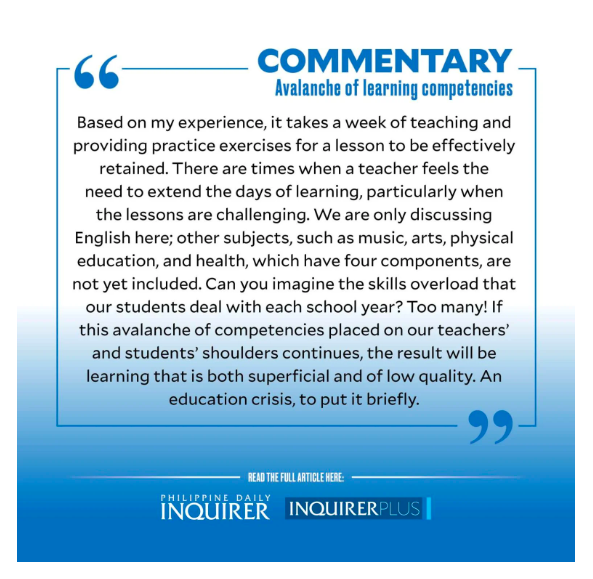Avalanche of learning competencies

The World Bank noted that the Philippines was experiencing an education crisis even before the pandemic hit our shores. According to its research, just 10 percent of our Grade 5 students are capable of meeting global academic standards due to their lack of proficiency in the instructions’ primary language, typically English, while the majority of Filipinos aged 15 lack knowledge of simple math skills.
Asking fellow Filipinos about this terrible issue will only elicit a multitude of depressing responses, among them the lack of qualified teachers, crowded classrooms, the dearth of high-quality teaching and learning resources, and insufficient funding allotted for education. However, as a public school teacher who has observed and participated in the actual process of teaching and learning, I can attest to the fact that the bulk of the unachievable learning competencies and skills required of our students is the main reason for the current crisis in education. Even though the number of learning competencies has been reduced from 14,171 to 5,689 in the recently published Most Essential Learning Competencies (MELCs), there are still issues with its implementation. While it is commendable that the Department of Education (DepEd) has reduced, merged, and dropped some competencies, students might still find those that are left to be overwhelming if they are implemented completely in the classroom.
For instance, each student must master 12 competencies within the first quarter of English in Grade 3. In some competencies, the division of a complex competency into smaller ones is even necessary. In light of this, mastering the subject, given eight weeks per quarter, has a snowball’s chance in hell. Based on my experience, it takes a week of teaching and providing practice exercises for a lesson to be effectively retained. There are times when a teacher feels the need to extend the days of learning, particularly when the lessons are challenging. We are only discussing English here; other subjects, such as music, arts, physical education, and health, which have four components, are not yet included. Can you imagine the skills overload that our students deal with each school year? Too many! If this avalanche of competencies placed on our teachers’ and students’ shoulders continues, the result will be learning that is both superficial and of low quality. An education crisis, to put it briefly.
As teachers, we currently don’t have enough days to cover all these competencies. Given this condition, we are currently left with two options in our classes: omit the remaining competencies, or teach all superficially. Inch deep yet a mile wide.
I urge the Marcos Jr. administration to evaluate the MELCs and simplify their reorganization. Instead of a few lessons a day, our students require in-depth instruction on important competencies. Listen to teachers when they say, “Back to basics!” I am a product of the old curricula, and when I was in Grade 5, I can read, write, and compute better than the Grade 5 pupils now. Why? Because we only had the appropriate number of lessons we needed to learn. The competencies in the elementary grades were not too ambitious. It was enough for the level of thinking and the mental capability of the learners. Remember, we in the education sector exist because of our learners. We should form and construct the learning competencies based on what they can do. Empathize with them. Know their boundaries. Learn their nature. Analyze the type of learners we truly have in the country.
——————
Marlon P. Labastida is currently pursuing his master’s degree in language and literacy education at the University of the Philippines. He is also a former reading teacher at La Salle Greenhills.
The post Avalanche of learning competencies appeared first on Cebu Daily News.

No comments: